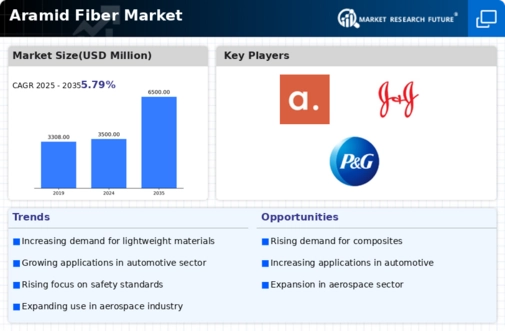Aramid Fiber Size
Aramid Fiber Market Growth Projections and Opportunities
The Aramid Fiber Market, a dynamic sector within the broader textile industry, is influenced by various market factors that shape its trajectory. One of the primary drivers of this market is the increasing demand for high-performance materials across multiple industries. Aramid fibers, renowned for their exceptional strength and heat-resistant properties, find applications in diverse sectors, including aerospace, automotive, and defense. The rising need for lightweight and durable materials in these industries propels the demand for aramid fibers. Aramid Fiber Market Size is projected to be worth USD 8.6 Billion by 2028, registering a CAGR of 10.75% during the forecast period (2021 - 2028).
Additionally, advancements in technology contribute significantly to the market dynamics. Continuous research and development efforts result in the introduction of innovative aramid fiber products with enhanced performance characteristics. Technological breakthroughs also lead to cost-effective manufacturing processes, making aramid fibers more accessible to a broader range of industries.
Market trends, such as the growing emphasis on sustainable and eco-friendly materials, impact the Aramid Fiber Market. As environmental concerns gain prominence, industries seek alternatives to traditional materials that are both high-performing and environmentally responsible. Aramid fibers, with their durability and recyclability, align with this sustainability trend, driving their adoption in various applications.
Global economic conditions play a pivotal role in shaping the Aramid Fiber Market. Economic growth or downturns in key regions directly influence the demand for aramid fibers. Industries experiencing expansion, such as automotive and construction, contribute to increased consumption of aramid fibers for applications like tire reinforcement and structural components.
Moreover, regulatory factors significantly impact the market landscape. Stringent safety standards and regulations in industries such as aerospace and defense drive the need for materials with exceptional mechanical and thermal properties, making aramid fibers a preferred choice. Compliance with regulatory requirements becomes a key consideration for manufacturers and end-users in the Aramid Fiber Market.
The competitive landscape and market dynamics are also influenced by raw material availability and pricing. Aramid fibers are derived from petrochemical-based raw materials, and fluctuations in oil prices directly affect the overall cost of production. Supply chain disruptions or changes in raw material prices can have a cascading effect on the Aramid Fiber Market, influencing product pricing and profit margins.
Consumer preferences and awareness regarding product attributes play a crucial role in shaping market dynamics. As end-users become more informed about the benefits of aramid fibers, there is a growing inclination towards products that incorporate these high-performance materials. This shift in consumer preference drives manufacturers to incorporate aramid fibers into a broader range of applications, expanding the market footprint.
Geopolitical factors also impact the Aramid Fiber Market, particularly in terms of trade relations and regional economic stability. Changes in trade policies, tariffs, or geopolitical tensions can disrupt the supply chain and influence market dynamics. Companies operating in the Aramid Fiber Market need to navigate these geopolitical factors to ensure a stable and resilient business environment.












Leave a Comment